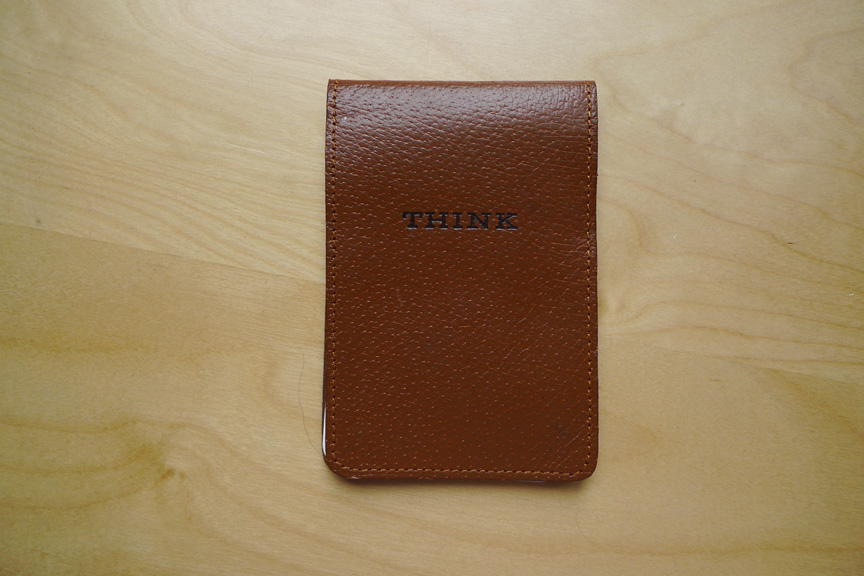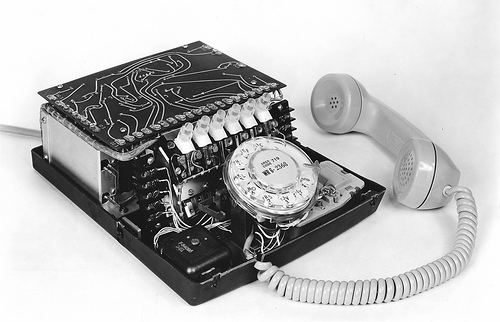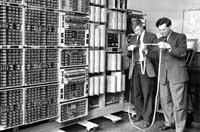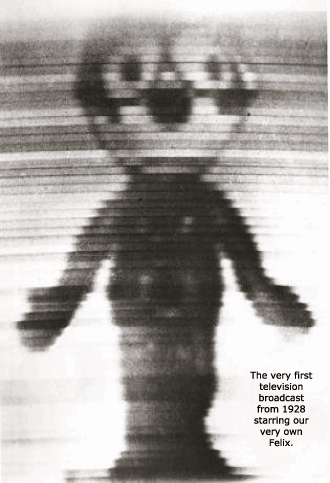The Proclamation of the European Environmental Criminal Court at World Venice Forum 2009 as read by a piano.
(Via Neatorama)
The Proclamation of the European Environmental Criminal Court at World Venice Forum 2009 as read by a piano.
(Via Neatorama)
From the SIGGRAPH 2004 emerging technologies demo, here’s the CirculaFloor, for when you want to play a bit of live-action Mario Bros. The tiles automatically rearrange themselves holonomically (albeit a bit slowly) depending on what direction the user is trying to walk.
(Reminded of this by Make)

The original IBM ThinkPad, a bit of corporate pen-and-paper swag from the 1980s that later inspired the name for their long-lived laptop line.
(Via A Continuous Lean via 5cience)

A beautiful photo set of Western Electric and Bell Labs test equipment from Flickr user Marc F. Vintage telephony pr0n.
here’s a toast to Alan Turing
born in harsher, darker times
who thought outside the container
and loved outside the lines
and so the code-breaker was broken
and we’re sorry
yes now the s-word has been spoken
the official conscience woken
– very carefully scripted but at least it’s not encrypted –
and the story does suggest
a part 2 to the Turing Test:
1. can machines behave like humans?
2. can we?Alan Turing by poet Matt Harvey, on the occasion of British prime minister Gordon Brown’s official posthumous apology to the mathematician and computer theorist. Originally read/published on the BBC Radio 4 broadcast Saturday Live, 12/9/2009.
(Via Language Log, from a mostly unrelated post on the language of homophobia in Jamaican culture, which is itself worth reading – depressing, but worthwhile)
Interactive Audio Visual installation for
Mekanism’s “After School Special” art show
location: gray area foundation for the arts http://www.gaffta.org/
concept/construction : suryummy
visuals : suryummy
audio : suryummy, herbie hancock, various manipulated retro logos
software : VDMX
This is like a model of the world I wanted to live in when I was a kid, somewhere between Tron’s MCP mainframe world, Cybertron, and Marble Madness.
(Via Make)

The “world’s oldest [working] computer”, the c.1949 Harwell/WITCH, is undergoing restoration for display at Bletchley Park’s National Museum of Computing, and will be exhibited next to the Colossus Mk2. I’d make them play chess against each other.
(Via El Reg)
The so-called “Mother of All Demos”, the technology presentation given by Doug Engelbart of the Stanford Research Institute, which introduced to the world a number of useful developments: hypertext, the computer mouse, timesharing, email, video conferencing… And this was a bit over forty years ago, just before the ARPANET went online. Pretty amazing times.
The videos are available in more digestible chunks over on Stanford’s MouseSite.

This papier-mâché Felix the Cat was the first image to be broadcast over experimental television in preparation for the first public RCA broadcast in 1928. Black and white and made of durable material, they had him revolving on a turntable, beaming out as a tiny test image so engineers could adjust the signal. Early TV technology fascinates me.
There’s more good info on early test patterns over at Design Observer.
Static: an Interactive Approach to Animation by Jack Lykins. Using a turntable and midi-controller via Max/MSP Jitter to drive the playback of an animation sequence. (via Cartoon Brew)